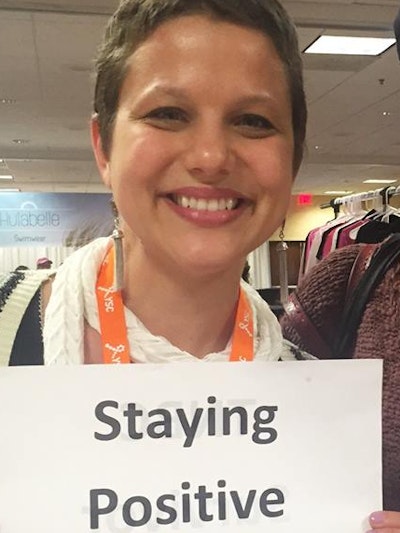December 11, 2018
Increments Matter
A Conversation with Lisa Carey, MD
Member of the TNBC Foundation Scientific Advisory Board
First, a special thanks to Lisa Carey for taking time to speak with me about this year’s SABCS. She called me on Friday evening, from the Newark airport, after a very busy week and a long day of travel to give me her insights from this meeting. That says a lot about the commitment that she has to the TNBC community. Dr. Carey is a distinguished professor of breast cancer research at the University of North Carolina Lineberger Comprehensive Cancer Center.
It’s natural for people facing a serious illness to hope for the big moment, the new drug or treatment that changes everything. While it’s not a cure, Herceptin and the drugs that have followed it have been that kind of game changer for HER2+ breast cancer. That hasn’t happened for TNBC, but as Lisa Carey says “incremental progress matters.”
San Antonio Breast Cancer Symposium 2018
Updates from SABCS for our TNBC community
There are clear and wonderful advances happening.
Lisa Carey, MD
Dr. Carey was excited by the Symposium hosted by the Triple Negative Breast Cancer Foundation the night before the official opening of the conference. “It’s really great to bring together all those people from different backgrounds. Those conversations generate new ideas and collaborations focused on tumor biology and the ways that immune cells interact with the tumor. There are clear and wonderful advances happening. They’re not yet enough but there is genuine enthusiasm about new options for these patients.”
Dr. Carey pointed to PARP inhibitors as one example of a promising area of treatment and research. “It took us forever to do the trials for these agents, in part because we had a kind of false start with the research, but it’s hard to ignore the survival improvements we are seeing in some patient groups with PARP inhibitors especially when they are combined with other drugs or immunotherapy.”
She also noted promising results from trials with antibody-drug conjugates. These complex therapies use an antibody that binds to an antigen found in the cancer cells but not so much in normal cells. The antibodies can deliver high doses of targeted chemotherapy to the tumor cells. There are several of these ADCs now being tested in trials for TNBC with positive results particularly in preventing relapses after primary therapy. “These represent a movement away from traditional chemotherapy approaches,” Dr. Carey says. “We’re not going to stop using chemo but we are looking at innovative ways of using the tools we have.”
The ultimate goal of course is to be able to cure every woman diagnosed with TNBC. Right now, the best hope for that is to improve the primary treatments so that women do not develop metastatic disease with better adjuvant and neoadjuvant therapies--and there is considerable positive movement on that front. Another goal is to make advanced disease more of a chronic condition much in the way Herceptin has for HER2+ disease and hormone therapy has for ER and PR positive breast cancer. “That’s where we need to go. We are just now getting the cluster of treatments that will make this happen.”
Dr. Carey is a recognized expert in identifying breast cancer subtypes, an area of great interest in TNBC, but she cautions against over interpreting the significance of these differences right now. “We know that TNBC is actually a group of biologic subtypes, but we need to focus on the therapeutic relevance of these differences. How does the subtype matter when we make clinical decisions about treatment? Right now, BRCA status is important and the luminal androgen type is amenable to AR directed therapy, but the others need a lot more research.”
Finally, Dr. Carey noted that there is great interest in immunotherapy and that there are clear signals of activity using immunotherapy to treat TNBC. It’s critical though to determine which patients benefit from these approaches and when and how to use these therapies.
“Immunotherapy is one piece of a complex puzzle. We have a long way to go but we are bringing these pieces together to bring about incremental changes that are making a difference for TNBC patients.”
December 7, 2018
Immunotherapy and TNBC: The Beginning of the Beginning
As immunotherapy has emerged as an important approach to treating a range of cancers, researchers have been increasingly interested in TNBC as a potential target for these agents. TNBC is an immunogenic cancer. That means that the tumor is more likely to generate an immune response to the cancer. Tumors that are immunogenic usually:
- Have multiple mutations
- Have cells called tumor infiltrating lymphocytes in them
TNBC meets these criteria. The first study to note a possible role for immunotherapy in TNBC was the KEYNOTE trial published in June, 2017. That study found that a single agent, pembrolizumab (Keytruda) produced an intriguing response in TNBC patients who had been heavily treated with chemotherapy. While the numbers were small, several of the these very advanced patients had responses that continued for months or even years. That study opened the doors to many trials looking at different aspects of immunotherapy for TNBC.
In October 2018, the IMPASSION study showed a significant response to a combination of an immunotherapy agent and chemotherapy as first line therapy in patients with metastatic or non-surgically treatable TNBC. There are now studies looking at combinations of immunotherapy with PARP inhibitors or chemotherapy, studies investigating which patients are most likely to benefit and when in the course of treatment, immunotherapy is most effective. There are also a number of new immunotherapy agents in trials.
Two of these studies were highlighted at SABCS 2018:
The first is a scientifically complex study aimed at determining which patients will have the highest response rates to an immunotherapy agent known as atezolizumab, the same agent in the IMPASSION study. That trial showed patients with a marker called PD-L1 benefit from treatment with atezolizumab. This will help researchers both design future trials and personalize treatment for TNBC patients.
The second study is a phase I trial of CAR-T therapy for patients that have a specific targetable mutation, including TNBC patients. CAR-T is a technically complex form of treatment in which cells are removed from the patient, genetically re-engineered and then injected back into the patient where the goal is to stimulate an ongoing immune response to the tumor. It has been used in clinical trials with patients who have a range of leukemias, lymphomas, non small cell lung cancer and other tumors, but this is the first trial to include TNBC patients.
This is a phase I study with small numbers of patients and very early results. Only four TNBC patients were included in the data presented at SABCS, Three of them had responses to their treatment, but it is still far too soon to draw conclusions about the future of CAR-T therapy for TNBC.
December 6, 2018
Earlier Adjuvant Chemotherapy Benefits Patients with TNBC
Adjuvant therapy is treatment given to patients after they undergo surgery and radiation therapy for their cancers. A new study indicates that in TNBC beginning treatment sooner is better. The study done in Peru showed that patients who began their adjuvant therapy within 30 days of completing treatment have better outcomes than those whose treatment is delayed. These results support evidence from other trials.
Physicians and patients need to balance the time required to recover from surgery and radiation with the benefits of starting adjuvant therapy sooner. Current guidelines call for beginning treatment within 4-6 weeks but these studies may change the view of the optimal timing.
“We can see that the time to adjuvant therapy is an independent prognostic factor for overall survival,” sad Zaida Morante, MD, who presented the study.
Carlos Arteaga MD of the University of Texas Southwestern Medical Center, who moderated the session in which this data was presented noted that more patients would be treated within 30 days in the United States.
Adding Capecitabine to Adjuvant Therapy Does not Improve Overall Survival in Early TNBC--With One Exception
This study was a phase 3 randomized trial in which one group of patients with early stage TNBC received capecitabine as adjuvant therapy after finishing neoadjuvant chemotherapy and surgery, while the other group got only the neoadjuvant treatment and surgery.. The CREATE-X trial showed no benefit either in disease free survival or overall survival for the patients getting the capecitabine. There was one group, however, for which the results were more promising--patients with the non-basal type of TNBC. That group did have statistically significant improvements in both key measures of the success of the treatment.
Effective treatment for early TNBC is critical as this is primary way to prevent the disease from recurring or spreading to other sites. Researchers are always working on ways to improve the initial treatments that patients receive. It’s also important not to subject patients to side effects from drugs or treatments that are not effective. This study will provide a basis for additional trials with the non-basal TNBC group and help refine the current standard of treatment for all women with TNBC.
December 3, 2018 - The Triple Negative Breast Cancer Foundation hosted a meeting at SABCS dedicated exclusively to TNBC.
This event brought together 34 of the world’s top researchers to discuss key areas of progress and the challenges that they face in moving forward with better treatments for this disease. Topics included Precision Medicine, PARP inhibitors, Immunotherapy, and a fascinating review of “Oncological Anthropology,” the genetics of TNBC in African American patients as well as an analysis of the treatment related toxicities and outcomes in specifically related to race in TNBC.
The topics are key indicators of the areas in which there is real progress in understanding TNBC and advancing treatment, as well as why this disease continues to be be so difficult. It is becoming increasingly clear that TNBC is not one disease. It is a collection of breast cancer types, and that while they share the “negatives,” the lack of hormone receptors and over production of the HER2 gene, they have distinct characteristics that influence treatment and prognosis. The efforts to develop precision medicine approaches, targeted therapies, depend heavily on understanding these biologic and genetic differences.
This was the best TNBC symposium we have had to date. There was hope in the room!
Hayley Dinerman, TNBC Foundation Executive Director
The area of PARP inhibitors continues to be intriguing, and promising, for some patients with TNBC, those with BRCA1 and 2 mutations. The likelihood is that PARP inhibitors will play a role in TNBC treatment in combination with other types of chemotherapy or immunotherapy.
Immunotherapy remains the potentially brightest star on the horizon. The October announcement of the positive results of the IMPASSSION130 trial open the doors to multiple new clinical trials using immunotherapy agents at different stages of the treatment process and in combination with each other and other agents.
The concept of Oncologic Anthropology speaks deeply to need to understand why certain groups of women get TNBC more often with poorer outcomes. This is a critical component of understanding TNBC and assuring that every patient has access to optimal care.
“This was the best TNBC symposium we have had to date,” TNBC Foundation executive director, Hayley Dinerman said, “This was an excellent meeting with a lively discussion and real strategizing about how to use the data to shape future research initiatives. There was a real sense that we are on the brink of making important advances in treating TNBC a reality. It was really exciting, and heartening to be in the same room with the researchers and clinicians that are doing the amazing work that will help improve the outcomes for our TNBC community. There was hope in the room.”
TNBC Foundation will summarize the results of the TNBC Symposium in a special publication that will be available next year.




